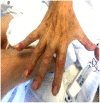Skin manifestations in patients hospitalized with confirmed COVID-19 disease: a cross-sectional study in a tertiary hospital
- PMID: 32970840
- PMCID: PMC7537241
- DOI: 10.1111/ijd.15180
Skin manifestations in patients hospitalized with confirmed COVID-19 disease: a cross-sectional study in a tertiary hospital
Abstract
Background: COVID-19 cutaneous manifestations have been recently described and classified in five different clinical patterns, including acral erythema-edema (pseudo-chilblain), maculopapular exanthemas, vesicular eruptions, urticarial lesions, and livedo or necrosis.
Objectives: The objective of this study was to examine the skin of hospitalized patients with a confirmed diagnosis of COVID-19 disease and describe the real prevalence of skin manifestations.
Methods: A cross-sectional study, which included hospitalized patients in Cruces University Hospital from April 14-30, 2020, with a laboratory-confirmed diagnosis of COVID-19 (with polymerase chain reaction and/or serology tests), was conducted. Entire body surface examination was performed by experienced dermatologists to search for cutaneous manifestations related to COVID-19 disease.
Results: From a sample of 75 patients, 14 (18.7%) developed cutaneous manifestations possibly related to COVID-19. We found six patients with acral erythema-edema (pseudo-chilblain) (42.8%), four patients with maculopapular exanthemas (28.6%), two patients with urticarial lesions (14.3%), one patient with livedo reticularis-like lesions (7.15%), and one patient with vesicular eruption (7.15%).
Conclusions: Our study provides a more plausible relationship between the main cutaneous patterns and COVID-19 in hospitalized patients as all of them had a confirmatory laboratory test. Skin manifestations are frequent but mild with spontaneous resolution. These findings are nonspecific and can be similar to other viral infections and adverse drug reactions in hospitalized patients.
© 2020 the International Society of Dermatology.
Figures



References
-
- Phelan AL, Katz R, Gostin LO. The novel coronavirus originating in Wuhan, China: challenges for global health governance. JAMA 2020; 323: 709–710. - PubMed
-
- European Centre for Disease Prevention and Control . Case definition and European surveillance for COVID‐19, as of 2 March 2020. 2020. https://www.ecdc.europa.eu/en/case‐definition‐and‐european‐surveillance‐.... Last accessed 9th May 2020.
-
- Recalcati S. Cutaneous manifestations in COVID‐19: a first perspective. J Eur Acad Dermatol Venereol 2020; 34: e212–e213. - PubMed
MeSH terms
LinkOut - more resources
Full Text Sources
Medical
Miscellaneous

